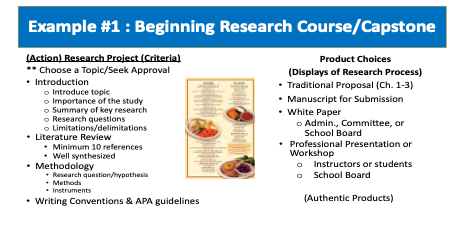-
The purpose of assessment is to diagnose, monitor, and direct student learning, make informed decisions about your curriculum and instructional methods, and ultimately evaluate students. As you begin to think more about the importance of assessment in evaluating the effectiveness of your teaching and assessing student learning, ask yourself:
-
How can I best monitor student progress toward the course learning outcomes or lesson objectives?
-
What is the most effective and authentic (i.e., close to real-world applications) way to evaluate student mastery of these CLOs?
-
What do the student assessment results tell me about my curriculum and instructional choices (i.e., Are these effective? Do I need to augment materials or activities? etc.)?
-
-
Let's look at two types of assessment: Formative and Summative (Scriven, 1981).
-
Type of
Assessment
Purpose or Use of Data
is to:
Best Serves
Formative
"FOR" Learning
To diagnose needs or monitor student progress and inform upcoming instructional planning/decisions.
Instructor
"AS" Learning
To enhance student development as self-directed learners, focus learners, and help students identify effective study strategies.
Students
Summative
"OF" Learning
To evaluate/judge
a) student performance on CLOs and/or lesson objectives, and
b) the effectiveness of instructional materials and activities.
Instructor
-
Formative Assessment Strategies:
-
If our goal is to improve student performance and persistence, then we must employ frequent and diverse forms of formative, low-stakes (or no-stakes) assessments and use the results to inform future lessons. These results should also inform students about their progress and perhaps illuminate where they might need to focus their attention and study. Some possible strategies are:
-
Application-oriented in-class learning activities/exercises (e.g., labs, creating concept maps; solving problems)
-
Brief reflections (e.g., minute papers, exit tickets, entrance tickets)
-
Weekly quizzes as low stakes, checks for understanding among students. These could be a mixture of lower-level terminology items and higher-level analysis, synthesis, and/or application questions.
-
Non-graded quizzes; iclicker questions; polling; minute papers; reflective entrance or exit tickets; lab reports; weekly exercises/homework, etc. to help students monitor their own progress.
-
Open book/Open notes exams (or even collaboratively with a peer).
-
Multiple choice and/or short answer exam questions that ask them to synthesize information.
-
Authentic tasks, case studies, completed individually or in small groups.
-
Require students to extrapolate from data and apply it to a situation they have not yet encountered in the class.
-
-
Summative Assessment Strategies:
-
Grading student performance in relation to the course learning outcomes is an important part of the instructor's job. In addition to the variety of formative assessments along one's journey toward mastery of core concepts and competencies, you will want to employ some more evaluative assessments to judge mastery of the CLOs. These summative assessments can be as diverse as the ways in which students learn. For example:
-
Traditional mid-term and final exams
-
Papers, essays, poster sessions
-
Special performances
-
Podcasts or video demonstrations
-
Open-ended, complex, and authentic projects or design challenges
-

-
In student-centered classrooms...
-
The purpose of assessment shifts from the assessment “of” student learning (i.e., for the purpose of grading, reporting, and evaluating) to the assessment “for” and "as" student learning (i.e., to make decisions that improve student learning and development).
-
Instructors utilize ongoing, informal formative assessment techniques that commonly (but not always) have nothing to do with grading (Saroyan & Amundsen, 2004). These techniques include written reflections (e.g., the clearest and muddiest point, exit ticket, iClicker or polling questions), discussions, non-verbal behavior (e.g., deer-in-the-eyes), conversations before or after class, journals, practice performances, and class participation. Again, most often these are no- or -low-stakes assessments.
-
Rather than use frequent assessments as accountability measures to ensure students are reading and showing up to class (i.e., reward/punishment), instructors design a variety of assessment activities that
- diagnose needs before instruction;
- monitor student progress during instruction (i.e., uncover misunderstandings, misconceptions, and knowledge gaps; facilitate deeper processing of the content);
- make a final judgment about the learning at a particular time (Scriven, 1981; Saroyan & Amundsen, 2004).
-
-
Instructors are concerned with developing self-directed, autonomous learners. Giving students choice has been shown to increase student motivation, performance, and autonomy (Ambrose, et al., 2010; Evans & Boucher, 2015).
-
Who said everyone needs to write a final paper? Why not let students have a say in how they demonstrate their learning? If the assignment expectations and grading criteria are clearly communicated to students (see rubric information below), there is no need to force everyone into the same type of performance. This does not imply that you won't ever require the same assignment of all students; rather, that you will think about when different performances or products can demonstrate the same expectations.
-
To do:
-
Review the type(s) of assessment (formative and/or summative) currently being used in your course. Are you currently providing students with multiple, no- or low-stakes opportunities to assess their own progress and adjust their efforts? Are students being asked to apply new information and skills in ways that are authentic to the discipline? In what ways might you do a better job of assessing the different types of knowledge?
-
References:
-
Evans, M., & Broucher, A. (2015). Optimizing the power of choice: Supporting student autonomy to foster motivation and engagement in learning. Mind, Brain, and Education, Vol 9 (2), 87-91. DOI: 10.1111/mbe.12073
-
Saroyan & Amundsen, (2004). Rethinking teaching in higher education: From a course design workshop to a faculty development framework. Sterling, VA: Stylus Pub.
-
Scriven, M. (1081) Evaluation thesaurus (3rd ed.). Inverness, CA: Routledge.
-



